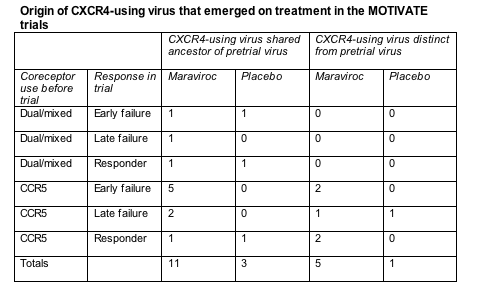 |
 |
 |
| |
HIV Seems Not to "Switch" Coreceptors in Maraviroc Failure, But Is From X4 Reservoir
|
| |
| |
XVI International HIV Drug Resistance Workshop
June 12-16, 2007
Barbados
Mark Mascolini
CXCR4-using virus that emerged during the phase 3 MOTIVATE trials of the CCR5 antagonist maraviroc appeared to come from pretreatment CXCR4 reservoirs, not from coreceptor "switching," Pfizer researchers reported [1]. But that conclusion left some workshop attendees wondering whether they had heard good news or just a clarification of how CCR5 drugs may fail.
Possible emergence of CXCR4-using virus during CCR5 antagonist therapy remains a major concern with this new class because research links CXCR4 virus to more advanced HIV disease. Some fear CCR5 antagonist therapy raises the risk of disease progression by driving HIV to mutate and thus switch its coreceptor preference from CCR5 to CXCR4. Pfizer undertook a study of virus from 20 MOTIVATE participants to see where CXCR4-favoring virus comes from if it appears during maraviroc therapy. MOTIVATE randomized people with heavy treatment experience to maraviroc plus a background regimen or to placebo plus a background regimen.
The strategy of this substudy involved cloning pretreatment and on-treatment virus from 16 people taking maraviroc and 4 taking placebo in MOTIVATE, then analyzing the coreceptor preference (or tropism) of that virus. Pfizer used Monogram's Trofile assay to determine tropism in 192 randomly selected baseline clones and 48 randomly selected on-treatment clones.
Clones of CXCR4-using virus from 14 of 20 people had identical or very similar sequences in pretreatment and on-treatment samples, a finding indicating that on-treatment CXCR4-favoring virus emerged from pretreatment pools of CXCR4 virus, not from a coreceptor "switch." In 10 of these 14 people, CXCR4 virus made up only 1% to 6% of the viral population, while in the other 4 people it made up more than 10% of the viral population.
For the remaining 6 people studied, phylogenetic analysis showed that viral sequences of on-treatment CXCR4-using clones were distinct from pretreatment CCR5-using clones--so they could not be CCR5 viruses that "switched" coreceptors under pressure from maraviroc. These on-treatment clones differed from pretreatment clones at 7 to 17 sites in the 35-site V3 loop of HIV envelope.
Pfizer concluded that changes in coreceptor use during therapy reflect selection of tiny preexisting viral populations of CXCR4-using HIV either:
1. Because genetically similar CXCR4-using clones were found in pretrial clones, or
2. Because on-treatment CXCR4-using clones were genetically distinct from pretreatment CCR5-using clones.
Marilyn Lewis from Pfizer summed up her inquest into the origin of CXCR4-using virus in a table:

The Pfizer team believes this study "supports a pre-existing CXCR4-using virus as the most likely origin of on-treatment CXCR4-using virus."
But Richard Harrigan (University of British Columbia), and perhaps other workshop attendees, wondered whether Pfizer's findings relieve clinical concerns about CXCR4 emergence or reflect a fine point of linguistics. When a CCR5 antagonist regimen fails, Harrigan asked, does it matter if a person's CCR5-favoring virus "switched" its coreceptor preference to CXCR4 or if--as this study showed--a distinct but undetectable CXCR4 population expanded because the CCR5 antagonist vanquished the CCR5 population? In the latter case, he proposed, individual viruses do not switch coreceptors, but the viral population does.
Reference
1. Lewis M, Simpson P, Fransen S, et al. CXCR4-using virus detected in patients receiving maraviroc in the phase III studies MOTIVATE 1 and 2 originates from a pre-existing minority of CXCR4-using virus. Antiviral Therapy. 2007;12:S65. Abstract 56.
|
| |
|
 |
 |
|
|